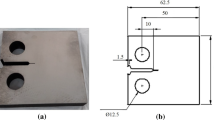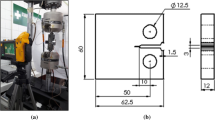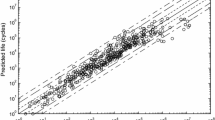Abstract
Background
Building S-N curves for materials traditionally involves conducting numerous fatigue tests, resulting in a time-consuming and expensive experimental procedure that can span several weeks. Thus, there is a need for a more efficient approach to extract the S-N curves.
Objective
The primary purpose of this research is to propose a reliable approach in the framework of thermodynamics for the rapid prediction of fatigue failure at different stress levels. The proposed method aims to offer a simple and efficient means of extracting the S-N curve of a material.
Methods
In this paper, a method is introduced based on the principles of thermodynamics. It uses the fracture fatigue entropy (FFE) threshold to estimate the fatigue life by conducting a limited number of cycles at each stress level and measuring the temperature rise during the steady-state stage of fatigue.
Results
An extensive set of experimental results with carbon steel 1018 and SS 316 are conducted to illustrate the utility of the approach. Also, the efficacy of the approach in characterizing the fatigue in axial and bending loadings of SAE 1045 and SS304 specimens is presented. It successfully predicts fatigue life and creates the S-N curves.
Conclusion
The effectiveness of the approach is evaluated successfully for different materials under different loading types. The results show that the temperature rise is an indicator of the severity of fatigue and can be used to predict life.













Similar content being viewed by others
Abbreviations
- \(A\) :
-
Conjugated force of internal variable
- \({A}_{cond}\) :
-
Cross-sectional area
- \({A}_{surf}\) :
-
Surface area
- \({c}_{p}\) :
-
Specific heat capacity
- e :
-
Specific internal energy
- \({\dot{E}}_{diss}\) :
-
Rate of dissipated energy
- \({\dot{E}}_{gen}\) :
-
Rate of internal energy generation
- \({\dot{E}}_{in}\) :
-
Rate of energy entering the material
- FFE:
-
Fracture fatigue entropy
- h :
-
Heat transfer coefficient
- \(k\) :
-
Thermal conductivity
- m :
-
Material Constant
- \({N}_{f}\) :
-
Number of cycles to failure
- \(\overrightarrow{q}\) :
-
Heat flux across the boundary
- \({R}_{\theta }\) :
-
Rate of temperature rise at the beginning of the fatigue process
- s :
-
Specific entropy
- t :
-
Time
- T :
-
Temperature
- \({T}_{s}\) :
-
Steady-state temperature
- V :
-
Volume of the gauge section
- \({V}_{k}\) :
-
Internal variable
- \({W}_{P}\) :
-
Mechanical dissipation due to plastic deformation
- \({\dot{W}}_{t}\) :
-
Rate of total energy generation
- \(\gamma\) :
-
Non-negative entropy generation
- \({\gamma }_{f}\) :
-
Entropy generation up to fracture
- \(\dot{\varepsilon }\) :
-
Total strain rate
- \({\varepsilon }^{e}\) :
-
Elastic strain
- \({\varepsilon }^{p}\) :
-
Plastic strain
- \(\rho\) :
-
Density
- \(\sigma\) :
-
Symmetric stress tensor
- \(\psi\) :
-
Helmholtz free energy
- \(\theta\) :
-
Temperature rise of gauge section (The difference between gauge section and remote area)
- \({\theta }^{d}\) :
-
Temperature rise due to damaging energies
- \({\theta }^{nd}\) :
-
Temperature rise due to non-damaging energies
- \(\Delta z\) :
-
Distance between gauge section and grips
References
Ye X, Su Y, Han J (2014) A state-of-the-art review on fatigue life assessment of steel bridges. Math Probl Eng 2014:1–13
Meneghetti G (2007) Analysis of the fatigue strength of a stainless steel based on the energy dissipation. Int J Fatigue 29(1):81–94
Huang Y, Li S, Lin S, Shih C (1984) Using the method of infrared sensing for monitoring fatigue process of metals. Mater Eval 42(8):1020–1024
Amiri M, Khonsari M (2010) Life prediction of metals undergoing fatigue load based on temperature evolution. Mater Sci Eng A 527(6):1555–1559
Luong MP (1995) Infrared thermographic scanning of fatigue in metals. Nucl Eng Des 158(2–3):363–376
Boulanger T, Chrysochoos A, Mabru C, Galtier A (2004) Calorimetric analysis of dissipative and thermoelastic effects associated with the fatigue behavior of steels. Int J Fatigue 26(3):221–229
Morabito A, Chrysochoos A, Dattoma V, Galietti U (2007) Analysis of heat sources accompanying the fatigue of 2024 T3 aluminium alloys. Int J Fatigue 29(5):977–984
Chrysochoos A, Huon V, Jourdan F, Muracciole JM, Peyroux R, Wattrisse B (2010) Use of full-field digital image correlation and infrared thermography measurements for the thermomechanical analysis of material behaviour. Strain 46(1):117–130
Jiang L, Wang H, Liaw P, Brooks C, Klarstrom D (2001) Characterization of the temperature evolution during high-cycle fatigue of the ULTIMET superalloy: experiment and theoretical modeling. Metall Mater Trans A 32(9):2279–2296
Fargione G, Geraci A, La Rosa G, Risitano A (2002) Rapid determination of the fatigue curve by the thermographic method. Int J Fatigue 24(1):11–19
Amiri M, Khonsari M (2010) Rapid determination of fatigue failure based on temperature evolution: Fully reversed bending load. Int J Fatigue 32(2):382–389
La Rosa G, Risitano A (2000) Thermographic methodology for rapid determination of the fatigue limit of materials and mechanical components. Int J Fatigue 22(1):65–73
Guglielmino E, Risitano G, Santonocito D (2019) A new approach to the analysis of fatigue parameters by thermal variations during tensile tests on steel. Procedia Structural Integrity 24:651–657
Palumbo D, Galietti U (2014) Characterisation of steel welded joints by infrared thermographic methods. Quant Infrared Thermogr J 11(1):29–42
De Finis R, Palumbo D, Ancona F, Galietti U (2015) Fatigue limit evaluation of various martensitic stainless steels with new robust thermographic data analysis. Int J Fatigue 74:88–96
Fatemi A, Yang L (1998) Cumulative fatigue damage and life prediction theories: a survey of the state of the art for homogeneous materials. Int J Fatigue 20(1):9–34
Basaran C, Yan CY (1998) A thermodynamic framework for damage mechanics of solder joints. ASME J Electron Packag 120(4):379–384
Naderi M, Khonsari M (2010) A thermodynamic approach to fatigue damage accumulation under variable loading. Mater Sci Eng A 527(23):6133–6139
Ontiveros V, Amiri M, Kahirdeh A, Modarres M (2017) Thermodynamic entropy generation in the course of the fatigue crack initiation. Fatigue Fract Eng Mater Struct 40(3):423–434
Mahmoudi A, Mohammadi B (2019) On the evaluation of damage-entropy model in cross-ply laminated composites. Eng Fract Mech 219:106626
Huang J, Li C, Liu W (2020) Investigation of internal friction and fracture fatigue entropy of CFRP laminates with various stacking sequences subjected to fatigue loading. Thin-Walled Structures 155:106978
Amiri M, Modarres M (2014) An entropy-based damage characterization. Entropy 16(12):6434–6463
Naderi M, Amiri M, Khonsari M (2010) On the thermodynamic entropy of fatigue fracture. Proc Math Phys Eng Sci 466(2114):423–438
Mahmoudi A, Mohammadi B (2019) Theoretical-experimental investigation of temperature evolution in laminated composites due to fatigue loading. Compos Struct 225:110972
Lemaitre J, Chaboche JL (1994) Mechanics of solid materials. Cambridge University Press
Halford G (1966) The energy required for fatigue(Plastic strain hystersis energy required for fatigue in ferrous and nonferrous metals). J Mater 1:3–18
Naderi M, Khonsari M (2012) A comprehensive fatigue failure criterion based on thermodynamic approach. J Compos Mater 46(4):437–447
Mehdizadeh M, Khonsari M (2018) On the role of internal friction in low-and high-cycle fatigue. Int J Fatigue 114:159–166
Jang J, Khonsari M (2018) On the evaluation of fracture fatigue entropy. Theoret Appl Fract Mech 96:351–361
Mahmoudi A, Khonsari MM (2022) Entropic Characterization of Fatigue in Composite Materials. Encyclopedia of Materials: Plastics and Polymers: Elsevier (vol. 2, pp. 147–162)
Mahmoudi A, Khonsari MM (2023) Rapid evaluation of fatigue limit using energy dissipation. Fatigue Fract Eng Mater Struct 46(6):2156–2167
Yang W, Guo X, Guo Q, Fan J (2019) Rapid evaluation for high-cycle fatigue reliability of metallic materials through quantitative thermography methodology. Int J Fatigue 124:461–472
Haghshenas A, Jang J, Khonsari M (2021) On the intrinsic dissipation and fracture fatigue entropy of metals. Mech Mater 155:103734
Guo Q, Zairi F, Yang W (2020) Evaluation of intrinsic dissipation based on self-heating effect in high-cycle metal fatigue. Int J Fatigue 139:105653
Teng Z, Wu H, Boller C, Starke P (2020) Thermography in high cycle fatigue short-term evaluation procedures applied to a medium carbon steel. Fatigue Fract Eng Mater Struct 43(3):515–526
Funding
This work is supported in part by the members of the Center for Innovations in Structural Integrity Assurance (CISIA) under the US National Science Foundation award number 2052810. Also, the lead author (A.M.) wishes to acknowledge that the research was supported in part by the Louisiana Experimental Program to Stimulate Competitive Research (EPSCoR), funded by the National Science Foundation and the Board of Regents Support Fund under Cooperative Agreement Number OIA-1946231 (CFDA # 47.083).
Author information
Authors and Affiliations
Corresponding author
Ethics declarations
Conflicts of Interest
The Authors declare to have no conflicts of interest.
Additional information
Publisher's Note
Springer Nature remains neutral with regard to jurisdictional claims in published maps and institutional affiliations.
Rights and permissions
Springer Nature or its licensor (e.g. a society or other partner) holds exclusive rights to this article under a publishing agreement with the author(s) or other rightsholder(s); author self-archiving of the accepted manuscript version of this article is solely governed by the terms of such publishing agreement and applicable law.
About this article
Cite this article
Mahmoudi, A., Khonsari, M. A Thermodynamic Framework for Rapid Prediction of S-N Curves Using Temperature Rise at Steady-State. Exp Mech 64, 167–180 (2024). https://doi.org/10.1007/s11340-023-01016-y
Received:
Accepted:
Published:
Issue Date:
DOI: https://doi.org/10.1007/s11340-023-01016-y




